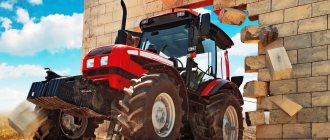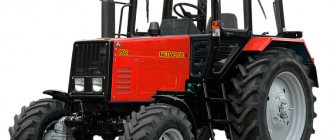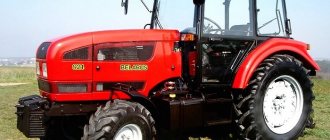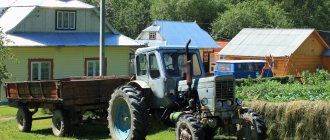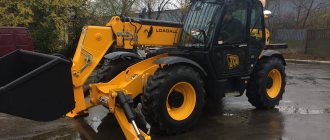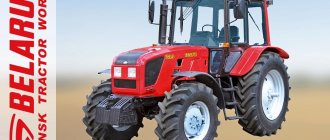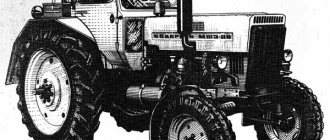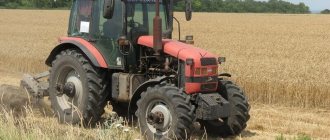Tractor "KD-35"
0
Source:
See all photos in the gallery
November 4, 1950 was noted in the chronicle of the labor exploits of Belarusian tractor builders as the day the serial production of KD-35 tractors began. The first-born of Minsk tractor builders enjoyed great and well-deserved success among field workers. The KD-35 tractors were equipped with 4-cylinder diesel engines producing 37 hp. the engine was distinguished by significant efficiency. Thus, for one hectare of plowing under average conditions, it consumed 13 kg of fuel. The tractor's fuel tank contained fuel for 10 hours of uninterrupted operation. Prototypes of the machine plowed up to 6 hectares of land in 10 hours. The tractor was not produced by the plant for long, only 9 months, until August 1951. During this time, 406 cars rolled off the assembly line. The production of diesel and starting engines for the KD-35 at the plant did not stop. They were supplied to the Lipetsk Tractor Plant. Subsequently, this engine was used on a wheeled universal row-crop tractor, on which factory designers had been working since 1948.
Which tractor is better - comparison of MTZ-40 and Lipetsk T-40
The Sorokovka T-40, produced by the Lipetsk plant, is in many ways identical to the MTZ-40 tractor in design terms. However, the production of the T-40 or “magpie”, as it was called, continued for a long time - from 1961 to 1995. Engines with a power of 37 and 50 hp were installed on this unit, rear-wheel drive and all-wheel drive modifications were made.
Some versions were equipped with an electric starter. A large number of T-40 agricultural machines produced in the 70-80s still operate effectively on many farms. Thanks to the continuous production of spare parts, owners can maintain tractors in good technical condition.
However, the Belarus T-40 tractor also has a number of disadvantages that MTZ does not have:
- The need for strict use of certain brands of oils capable of operating at temperatures above 55°C.
- Prolonged operation at low speeds and idling led to malfunctions.
- Problems with starting at low temperatures.
- Incorrect operation of the air cooling system - in cold weather - underheating of the engine, in summer - excessive overheating.
- It is prohibited to operate the unit without a fan casing.
- Poor cabin heating in cold weather, uncomfortable temperature in summer.
So, it’s quite difficult to say unequivocally which technique is better and which is worse. Each model has its pros and cons.
MTZ-1 and MTZ-2
0
Source:
The Belarus universal wheeled tractor was designed to work with mounted, semi-mounted and trailed agricultural machines. The design of the tractor was made in two modifications: MTZ-2 - for inter-row cultivation of low-stem crops with matching tracks of the front and rear wheels and MTZ-1 - for processing high-stem crops with close front wheels. The tractor was designed to operate on two wheels: low-pressure rubber cylinders and wheels with a rigid steel rim with spurs. The tractor had an independent power take-off shaft drive, a hydraulic system for lifting mounted implements, and was equipped with a removable adjustable tow hitch. July 18, 1949 became a significant day for all tractor manufacturers. The first Belarusian factory-designed wheeled tractor emerged from the gates of the experimental workshop. A prototype of a wheeled tractor subsequently became the basis for the creation of the MTZ-2 serial machine. In 1949, 7 prototypes were produced and underwent lengthy factory tests. A historical date for the plant’s staff was 1953, when on October 14, the assembly of the MTZ-1 and MTZ-2 tractors, created by the plant’s designers, was completed on the main conveyor. These machines determined the entire further specialization of the plant in the production of wheeled universal row-crop tractors.
×
0
Source:
KT-12 and KT-12A
0
Source:
In the spring of 1951, the MTZ team received a very important government task - to master the production of skidders, which were in great demand in the logging industry. The KT-12 gas generator tractor is a special tracked vehicle designed for forest skidding. It appeared in the USSR in the first post-war years. There were no analogues to it in any country in the world. Previously, skidding was carried out by horse-drawn vehicles, manual or mechanical winches. The KT-12 tractor was created by designers of the Kirov plant in Leningrad in collaboration with scientists from the Leningrad Forestry Academy. The KT-12 tractor was produced at the Kirov plant until 1951. Now it was necessary to establish its production at the Minsk Tractor Plant. Only three months were allotted to resolve all organizational issues. So, in the short history of its existence, MTZ had to develop a second (after the KD-35) machine, and, moreover, not of its own design. On August 15, 1951, the first batch of KT-12 skidding machines rolled off the main conveyor of the tractor assembly shop. During the production process, the tractor underwent modernization aimed at improving the performance of the machine. In a short period of time, factory designers, by changing a number of components and parts, increased the warranty period of the machine by 1.5 times.
TDT-40
0
Source:
In the early 50s, the USSR Ministry of Forestry Industry stated that the KT-12A with its gas generator installation did not meet the increased requirements. Considering the disadvantages of the tractor, the ministry decided to abandon this machine altogether and raised the question of creating a new, more reliable skidder with a power of 60 hp instead. Having analyzed the situation, the designers and management of MTZ recognized the feasibility of creating a more powerful skidder, but also expressed the opinion that one powerful class of tractor for all zones in all forestry operations would be uneconomical. It was necessary to design a medium-power skidder that could be created on the basis of the KT-12A by installing a diesel engine of a Belarus wheeled tractor on it. In 1954, they developed the design of such a tractor, giving it the brand TDT-40. The tractor was intended for transporting logs directly from the cutting area. In addition to timber skidding, it was indispensable in logging and in all kinds of transport work in off-road conditions. Based on the results of operational tests in 1955, the interdepartmental commission stated that the TDT-40 tractor was very necessary for the USSR Ministry of Forestry Industry and it was advisable to establish its production in a short time. By decision of the USSR Ministry of Tractor and Agricultural Engineering, serial production of TDT-40 diesel tractors began at MTZ in May 1956. By the end of the year, their number reached 3,430. In the same year, design work was completed and the first experimental D-50 diesel engines for the promising tractor were manufactured. The new engine exceeded the power of its predecessor by 10 hp, was smaller in size and 350 kg lighter.
TDT-54 and TDT -60
0
Source:
To work in the forests of the Urals, Siberia and the Far East, more powerful skidders were required than the TDT-40. The Ministry of Automotive Industry instructed the designers of the Minsk Tractor Plant to develop a project for such a tractor in conjunction with the Scientific Research Autotractor Institute (NATI) according to the technical requirements of the Ministry of Forestry Industry of the USSR. Initially, the tractor was given the brand TDT-54. To increase productivity, a D-54 diesel engine with a power of 54 hp was used. tractor DT-54 of the Kharkov Tractor Plant. After the skidder TDT-54 received the go-ahead from the state commission for mass production, a detailed analysis of each unit was carried out. As a result, it was decided to modernize most of its components. In addition, the D-54 diesel engine was boosted to 60 hp. and as a result, the tractor received a new name TDT-60. In 1956, four of its prototypes passed all control state tests under production conditions at the Vakhtansky timber industry enterprise in the Gorky region. The simultaneous production of two tractors, MTZ-2 and TDT-40, completely different in design and purpose, put the plant in a difficult position. The plant did not have the opportunity to simultaneously develop two different productions: the production of the MTZ-2 tractor, which was extremely necessary for agriculture, and the TDT-40 tractor, in which the USSR Ministry of Forestry Industry was interested. Technical and economic calculations showed that the Minsk Plant needs to specialize in the production of wheeled universal row-crop agricultural tractors. The management of the plant submitted a proposal to the ministry - to stop production of the TDT-40 tractor at MTZ, transferring it to the plant in Karelia, and the developed TDT-60 model to the Altai Tractor Plant. By decree of the USSR government of January 30, 1956, the Onega Machine-Building Plant in Petrozavodsk was transferred to the Ministry of Tractor and Agricultural Engineering of the USSR for the production of TDT-40 tractors. Before that, it was under the jurisdiction of the USSR Ministry of Forestry Industry. In 1957, without stopping the production of TDT-40 at MTZ, the development of the tractor began at the Onega Tractor Plant. In total, until 1958, MTZ produced 12,977 TDT-40 tractors. In 1957, the TDT-60 tractor was put into serial production at the Altai Tractor Plant. This was the end of the history of skidders at MTZ, where for 7 years they were produced in parallel with wheeled ones.
MTZ-5
0
Source:
Time passed, and with it the requirements for the manufactured MTZ-2 tractor grew. It had a low transport speed (13 km/h) and an insufficient number of gears. The tractor began to lag behind in terms of fuel efficiency and material consumption. It was necessary to increase the reliability and service life of the machine. Having summarized the experience of operating MTZ-2 tractors, taking into account the state and level of tractor manufacturing, the plant’s design team in 1955-1956. carried out work on a radical modernization of the machine. This made it possible not only to eliminate existing shortcomings, but also to expand the scope of application of the machine and improve technical and economic indicators. This is how new models of the Belarus tractor appeared: MTZ-5 (1956 model). MTZ-5M and MTZ-5L (samples of 1957). MTZ-5, possessing great versatility, had an independent power take-off shaft drive, a more powerful and economical engine, and a hydraulic linkage system with remote cylinders.
MTZ-5S
0
Source:
In 1959, after design improvements, production of the MTZ-5LS and MTZ-5MS tractors began. The letter “C” in the designation meant “high-speed”. Engine power was increased to 48 hp. (instead of 45) by increasing the speed to 1600 rpm (instead of 1500). The operating speed range was set within 5-10 km/h. The number of working gears in the gearbox was increased from four to five. Otherwise, there were no fundamental differences from the MTZ-5L and MTZ-5M tractors. Production of high-speed cars began in 1959.
Design Features
The MTZ-40 model turned out to be maneuverable and had good cross-country ability, thanks to its high ground clearance and embossed pattern on the tires.
And despite the fact that there was no power steering, the car was not difficult to drive.
The tractor reached speeds of up to 24 km/h, allowing it to be used for transporting goods.
Dimensions and weight
Compared to other models, the MTZ-40 was considered very small and light. Its weight was 2.6 tons, and its overall dimensions (HxLxW) were 2.1x3.6x1.6 m.
Engine
The diesel engine with which the tractor was equipped was considered very economical at that time and consumed only 182 g/hp. at one o'clock.
Important The best Huter walk-behind tractors: technical characteristics, attachments, owner reviews
This was achieved thanks to changes in the power system and improvements in gas distribution.
Many engine parts have undergone additional improvements, which made it possible to achieve a power of 45 hp.
Transmission
The main task of the designers was to increase the operational period between repairs and they achieved this by strengthening the structure and hardening the surfaces of the couplings.
The tractor has a mechanical transmission with reverse, and a distinctive feature is that reverse is available for all 7 gears.
Its use was useful not only when performing maneuvers, but also for operating additional equipment.
Advantages and disadvantages
The disadvantages include the following factors:
- Imperfect engine cooling system;
- Poor starting in cold weather;
- The cabin heating system could not cope with the task.
There are many more advantages:
- The model has a high degree of maneuverability;
- Excellent off-road performance;
- It is easy to operate;
- Reliable power unit;
- Suitable for other models of attachments;
- Maintenance is not difficult;
- The presence of reverse, with which you can carry out all types of work.
MTZ-40 became the founder for the development of many subsequent modifications.
MTZ-7
0
Source:
In 1958, the design was finalized, prototypes were made, tests were carried out, and drawings for the MTZ-7 all-terrain tractor with four driving wheels were issued in preparation for production. The first tractor design was developed using the front drive axle from the military all-terrain vehicle GAZ-67, did not have an adjustable track width of the front wheels and therefore did not provide for row-crop work. Due to the insufficient strength of the GAZ-67 bridge, the tractor did not pass the tests. The problem was solved after a GAZ-63 drive axle was installed on the tractor. The production of cabins for Belarus tractors began. The design of the removable cabin made it possible to use it on the tractor completely closed and in the form of an awning. With the use of such a cabin, the working conditions of the tractor driver have significantly improved.
MTZ-50
0
Source:
Until 1959, MTZ had the capacity to produce only 18,000 wheeled tractors of the MTZ-2 type, 6,000 TDT-40 tracked skidders and 40,000 D-40 engines. Serial production of the MTZ-5, MTZ-5M, MTZ-5L tractors was still underway, work was carried out to modernize them, and in 1956 the designers basically designed a new diesel engine for the future MTZ-50 tractor. There was great interest in the creation of a new promising row-crop tractor not only at the plant, but also in the country. The technical design of the tractor was completed in 1957 and approved by the Main Scientific Automotive and Tractor Institute. In 1958, the experimental workshop produced several prototypes of the tractor. Based on the test results, the scientific and technical council of the VO "Soyuzselkhoztekhnika" recommended the wheeled universal row-crop tractor class 1.4 "Belarus" MTZ-50 for mass production. The MTZ-50 tractor was equipped with a 55 hp diesel engine, the weight of the machine was reduced by more than 400 kg. The tractor transmission was equipped with a 9-speed gearbox, providing a speed range ranging from 1.65 to 25 km/h.
Technical characteristics of the T-40 tractor
The T-40 self-propelled vehicle is a universal vehicle designed for cultivating land, as well as for carrying out work related to construction and cargo transportation.
Tractor T-40M:
The base of the series is considered to be a tractor labeled T-40M; the model is equipped with rear-wheel drive. The second most common model is the T-40AM. The modification is a T 40m tractor, the technical characteristics of which are supplemented by the presence of a drive on the front axle in order to increase the maneuverability of the installation. Modifications are equipped with two engines, D-144 (50 hp), or D-37 (36.5 hp). The power of the power plants is enough to complete the assigned tasks.
Technical characteristics of the tractor t 40 am (m):
| Explanation | Index | |
| T-40M | T-40AM | |
| Traction, class | 0,9 | |
| Drive unit | 4X2 | 4X4 |
| Dimensions, mm (L*W*H) | 3660*1625*2370 | |
| Ground clearance, mm | changeable | |
| Installation footprint size, millimeters | 1200 — 1800 | |
| Tractor weight t 40, kg | 2370 | |
| Developed speed, km/h | 1,6-27 | |
| Engine markings | D-37 (37hp), D-144 (50hp) | |
| Tractor gearbox t 40 | Mechanics | |
| Forward (backward) gears, pcs. | 7(7) | |
How much a T 40 tractor weighs depends on several points. It is important to know the modification of the vehicle; a unit with all-wheel drive is heavier. In addition, it is important what attachments the installation is equipped with.
You can also read about Tractor K-700 “Kirovets” - Technical characteristics
MTZ-52
0
Source:
In 1959, based on the results of state tests, the design of the MTZ-50 tractor was finalized, the necessary documentation was issued and put into preparation for production. Based on the MTZ-50 tractor, a modification of the all-terrain tractor with four driving wheels, the MTZ-52, was developed. Due to lower slipping losses, the fuel efficiency of the MTZ-52 tractor is higher at all operating limits than the MTZ-50 tractor. On November 14, 1959, the Council of Ministers of the USSR issued a resolution “On the organization of specialized production of wheeled tractors, motorcycles and engines for them at enterprises of the BSSR.” One of the points of the document stated: 2. Oblige the Council of Ministers of the BSSR to ensure: c) the production of Belarus MTZ-50 tractors starting in 1961 and MTZ-52 tractors starting in 1962, increasing the production of tractors of these brands to 75,000 units in 1965 year. The Council of the National Economy of the BSSR, by its decision of December 19, 1961, decided: 3. For a non-stop transition to a new tractor model, provide for the phased introduction of the MTZ-50 tractor, for which: - approve the transition model MTZ-50 tractor for production at MTZ for 1961-1962 PL on the chassis of the MTZ-50 tractor with a serial D-48 PL engine, boosted to 50 hp. - production of MTZ-50 tractors with the D-50 engine will begin in the fourth quarter of 1962. 1960 The plant is under reconstruction. New equipment was installed in the workshops and outdated equipment was replaced. The design of the MTZ-50 tractor was finalized, the necessary documentation was issued and put into preparation for production. Based on the MTZ-50 tractor, the plant's design team developed a modification of the high-cross-country tractor with four driving wheels MTZ-52. This machine complemented the basic model and expanded its scope of application in agricultural and transport work, especially in conditions of high soil moisture.
T-40 tractor engine
The base engines of the self-propelled unit are diesel units from a tractor plant located in the city of Vladimir. The first tractors were equipped with a D-37 (38 hp) unit, later models came with a D-144 (50 hp) engine. The motors were started with an electric starter or a gasoline starting mechanism (PD-8).
Both units are 4-cylinder, perform four strokes, and are air cooled. A characteristic feature of the motors is removable cylinders arranged in a row with special fins for heat transfer. Manual adjustment of the valves is also provided, which is carried out every 480 hours worked by the tractor. During the adjustment process, the presence of a sufficient amount of lubricant and the sealing of parts related to the camshaft are monitored.
Power plant D-144:
Indicators of the power plant of the T-40 tractor, D (37/144):
- Installation type – diesel internal combustion engine;
- Number of engine strokes – 4;
- Number of engine chambers, pcs. - 4;
- Engine mixture formation – direct injection of the working mixture;
- Engine cooling – air;
- Engine power, kW/hp – (27.2/37)/(36.8/50);
- Engine crankshaft speed, min-1 – 1500/1800;
- Operation of engine chambers, order – 1-3-4-2;
- Installation volume, liters – 4.15;
- Engine chambers, location - in a row;
- Engine chamber diameter, millimeters – 105;
- Distance from bottom dead center to top dead center, millimeters – 120;
- Engine weight (depending on configuration), kg. – 375-390;
- Specific consumption of a diesel engine, g/kW*h – 239/241;
- The starting device is a single-cylinder two-stroke carburetor engine PD-8 (7 hp).
MTZ-50X
0
Source:
In 1963, the design development was completed and prototypes of the MTZ-50 cotton-growing tractor were produced. The tractor is designed for cultivating and harvesting cotton in a four-row machine system with a row spacing of 90 cm. The MTZ-50X tractor was fundamentally different from the MTZ-50 tractor in the design of the front axle - it had one guide wheel. The final drive assembly with additional gearboxes was also changed. All necessary tests of the tractor were completed in 1966, after which preparations began for its mass production by factory services. Production of the MTZ-50X tractor lasted eight years: from 1969 to 1977. Then production was transferred to the Tashkent Tractor Plant.
Three tracked modifications were created on the basis of the MTZ-50 tractor, and the unit unification with the MTZ-50 tractor was more than 62%. Tracked modifications were unified by 95-98%. In 1967, a version of the T-54V tracked tractor was put into production in two modifications: T-54V-S1 with a track width of 950 mm for cultivating vineyards with row spacing of 1.8 m or more, and T-54V-S2 with a track width of 85- mm for cultivating vineyards with row spacing of 1.5 m. In 1968, production of the T-54L tractor began.
Gearbox of the T-40 tractor
The gearbox installed on the T 40 tractor has the following characteristics: eight-speed, four-wheel drive with mechanical shifting and slow transmission. The presence of reverse gear improves the characteristics of the tractor. Thanks to such indicators, the machine easily copes with the assigned tasks.
Gearbox tractor T-40:
The peculiarity of the gear switching mechanism is a structurally different arrangement of the gearbox shafts, the parts are placed transversely. This solution made it possible to make the box shorter and lighter, and also to place it in one housing with the parts and mechanisms of the rear axle.
Separate mechanisms and controls of the low-speed installation are attached to the front partition of the box. This is helped by the threaded connection on the product. The box partition itself is attached to the clutch housing; for this reason, the clutch is depressed before adjusting the plow.
The back part of the box with fasteners, due to which the mechanisms that control the body kit equipment are mounted. The power take-off shaft extension is also attached here. The brake pipes are located on the edge. If the speed does not turn off, the clutch is depressed and the gear is transferred to a lower gear.
MTZ-80
0
Source:
In 1966, Decree of the Council of Ministers of the USSR No. 606 was issued on the creation of a universal row-crop tractor with a power of 75-80 hp. traction class 1.4. The designers created such a tractor by modernizing the MTZ-50 tractor, assigning it the MTZ-80/82 brand. In addition to increasing the power of the serial engine, a significant number of improvements were made to the design of this tractor. In 1972, state tests of the MTZ-80/80L tractor (with electric starter and starting engine) were completed. Tests have shown that the number of machines and implements mounted with the tractor has increased to 230 items. High speed (up to 35 km/h) made it possible to use the tractor more efficiently for transport work. In 1974, the plant began serial production of the MTZ-80. The tractor was conceived as a base one, taking into account the development of a new family of unified energy-rich tractors, both wheeled and tracked. The main differences between the MTZ-80 tractor and the MTZ-50 tractor were the following: A reduction gearbox was installed in the gearbox, doubling the number of gears - 18 forward gears and 4 reverse gears; Damping springs were introduced into the clutch coupling, the design of the flywheel was changed - it became flat, which improved ventilation of the entire clutch compartment and cleaning the cavity from wear products of rubbing surfaces; A creeper has been introduced - a gear reducer, which expands the speed range of the tractor. Its use allowed the tractor to move at speeds of up to 1.3 km/h; The automatic differential lock of the rear axle has also undergone changes. Now the blocking could be carried out while the tractor was moving; A change in the design of the rear PTO drive made it possible to obtain two rotation speeds instead of one; The hydraulic suspension system has also been modernized. It is equipped with a hydraulic adhesion weight increaser (GSV), a force and position regulator. The system's load capacity has been increased to 2000 kg (instead of 1500) by increasing the pressure in the system from 130 to 160 kg/cm2; The Minsk Motor Plant was involved in modernizing the engine. The engine had two modifications with electric start. The crankshaft speed was raised to 2200 rpm.
Model description
Initially, a wheeled row crop unit of 0.9 traction class was developed for processing light soil, plowing, harvesting, working in the garden, greenhouses, for the public sector, and transporting various cargoes. The layout uses a design characteristic of MTZ with a convenient placement of the engine in front and the cabin in the rear.
Important Which cultivator oil can be poured into the engine or gearbox
Engine
Belarus MTZ-40 was equipped with a four-cylinder diesel engine of 45 hp. Thanks to a number of improvements, the designers managed to significantly reduce diesel fuel consumption: the cleaning filters were modernized, the sections of the motor head were increased, and valve plates of larger diameter were installed. The tractor was started using a carburetor starting engine.
Transmission
The basic version of the gearbox is a dry single-disc permanently closed clutch. A number of effective improvements have been made in the design of the MTZ-40, thanks to which maximum interchangeability with other MTZ models has been achieved:
- replacing ball bearings with roller bearings
- installation of lightweight stamped parts
- reinforced gearbox design
- imparting high strength to jaw couplings and gears using high-frequency hardening and carburization
- installation of cast ribs on the box body.
Transmission
The installation of a mechanical reverse transmission on an agricultural unit made it possible to rationally use the speed range during forward and reverse movement. Some modifications of the MTZ-40 tractor were equipped with a creeper for working at reduced speeds when planting seedlings and harvesting industrial crops.
Chassis
The front wheels of the MTZ-40 tractor, with a smaller diameter, unlike the rear ones, were installed on a special damper suspension and were driving wheels. Thanks to its high ground clearance and raised herringbone agricultural protector, the unit was distinguished by increased cross-country ability, regardless of the quality of the soil. Like all wheeled tractors, the frame of the agricultural machine is semi-frame.
Cabin, controls
Belarus MTZ-40 became one of the first such units equipped with a cabin. Worm control is installed without hydraulic booster. For that time, a comfortable cabin was a significant advantage. However, many complaints from drivers were caused by the inconvenient location on the dashboard of levers and control handles for both the tractor itself and the attachments.
Hydraulics
A design feature of the Belarus MTZ-40 tractor was the drive of a gear pump of separate-unit hydraulics, which affected the placement of the engine and some other components of the machine. A sufficient level of performance of the on-board hydraulic system provided the possibility of operation with KUN - front loaders of various modifications: forks, buckets for agricultural, construction work, and also for loading and unloading.
